Analysis of Nature, Formation, and Management of Business Organisation
VerifiedAdded on 2023/06/07
|10
|2455
|396
Report
AI Summary
This report provides a comprehensive analysis of business organizations in the UK, focusing on their nature, formation, and management. It begins with an introduction to business law and the Companies Act 2006, highlighting the various business structures such as sole proprietorships, partnerships, limited liability partnerships, and limited liability companies. The report discusses the advantages and disadvantages of each structure, including tax implications and liabilities. It also examines the organizational structure of businesses in the UK, emphasizing the importance of different departments and relevant laws like employment law and health and safety regulations. Furthermore, the report offers specific recommendations for IOM Solutions, suggesting a partnership structure to enhance business growth. The conclusion emphasizes that the choice of business structure depends on individual needs and capacity, underscoring the supportive business environment in the UK and advocating for informed decision-making in business formation.
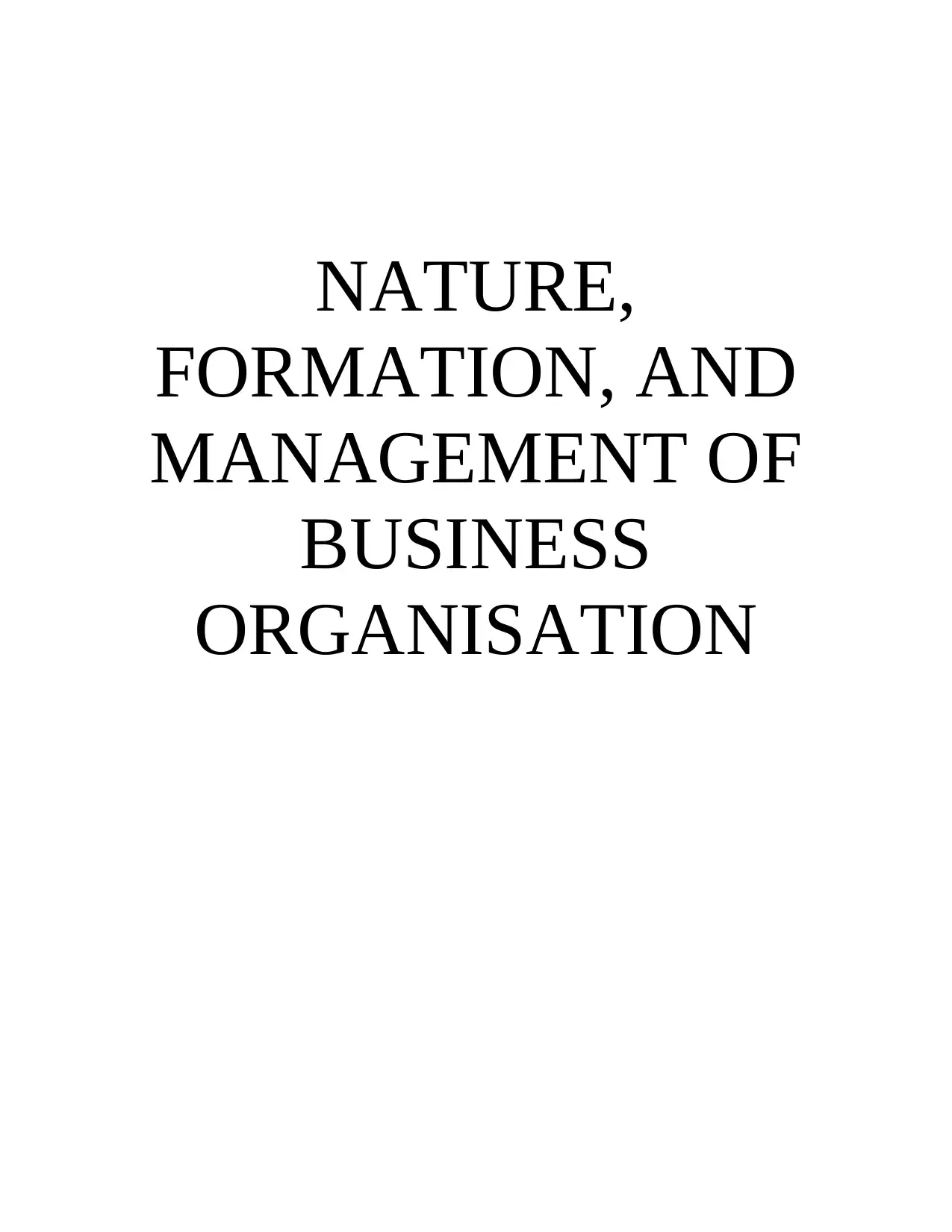
NATURE,
FORMATION, AND
MANAGEMENT OF
BUSINESS
ORGANISATION
FORMATION, AND
MANAGEMENT OF
BUSINESS
ORGANISATION
Paraphrase This Document
Need a fresh take? Get an instant paraphrase of this document with our AI Paraphraser
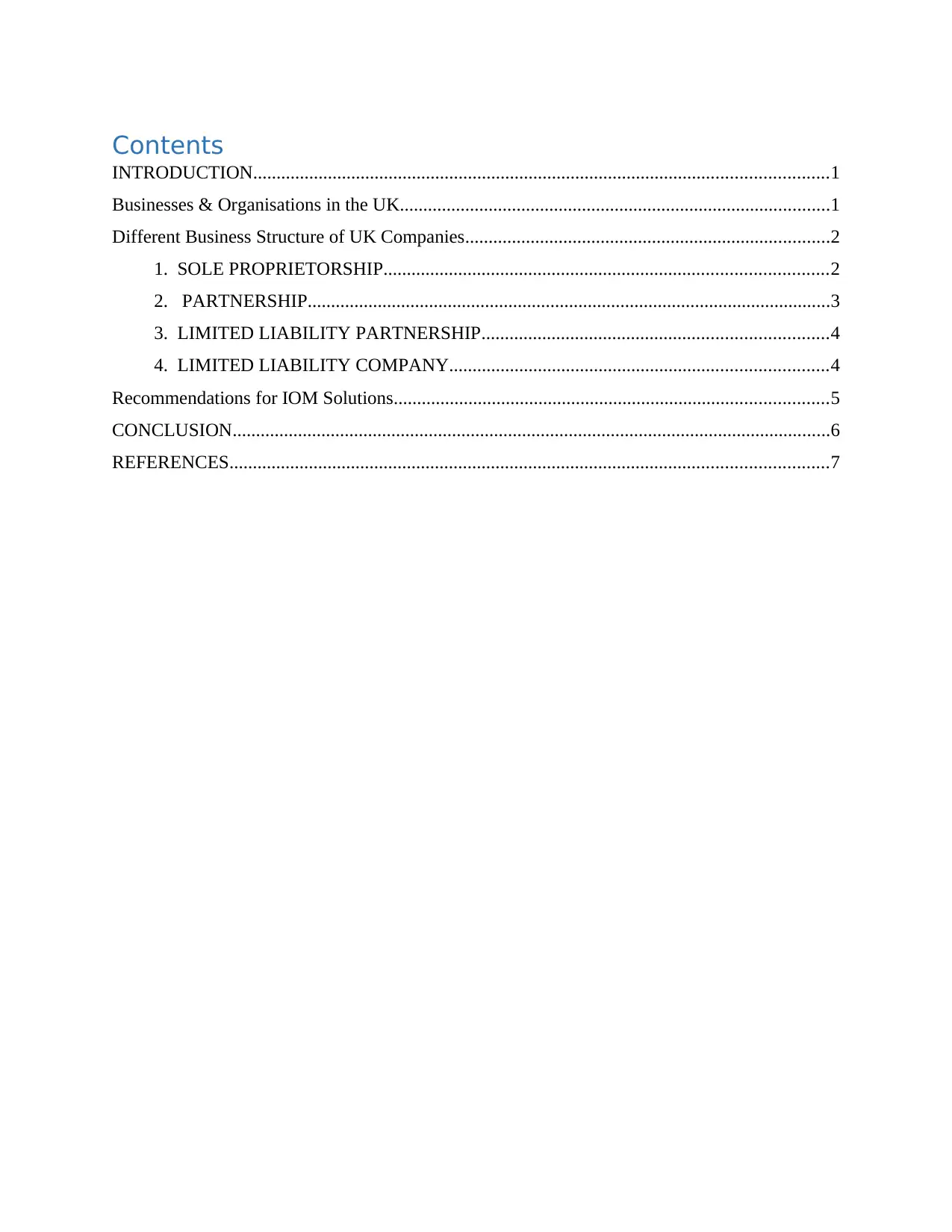
Contents
INTRODUCTION...........................................................................................................................1
Businesses & Organisations in the UK............................................................................................1
Different Business Structure of UK Companies..............................................................................2
1. SOLE PROPRIETORSHIP...............................................................................................2
2. PARTNERSHIP................................................................................................................3
3. LIMITED LIABILITY PARTNERSHIP..........................................................................4
4. LIMITED LIABILITY COMPANY.................................................................................4
Recommendations for IOM Solutions.............................................................................................5
CONCLUSION................................................................................................................................6
REFERENCES................................................................................................................................7
INTRODUCTION...........................................................................................................................1
Businesses & Organisations in the UK............................................................................................1
Different Business Structure of UK Companies..............................................................................2
1. SOLE PROPRIETORSHIP...............................................................................................2
2. PARTNERSHIP................................................................................................................3
3. LIMITED LIABILITY PARTNERSHIP..........................................................................4
4. LIMITED LIABILITY COMPANY.................................................................................4
Recommendations for IOM Solutions.............................................................................................5
CONCLUSION................................................................................................................................6
REFERENCES................................................................................................................................7

⊘ This is a preview!⊘
Do you want full access?
Subscribe today to unlock all pages.

Trusted by 1+ million students worldwide
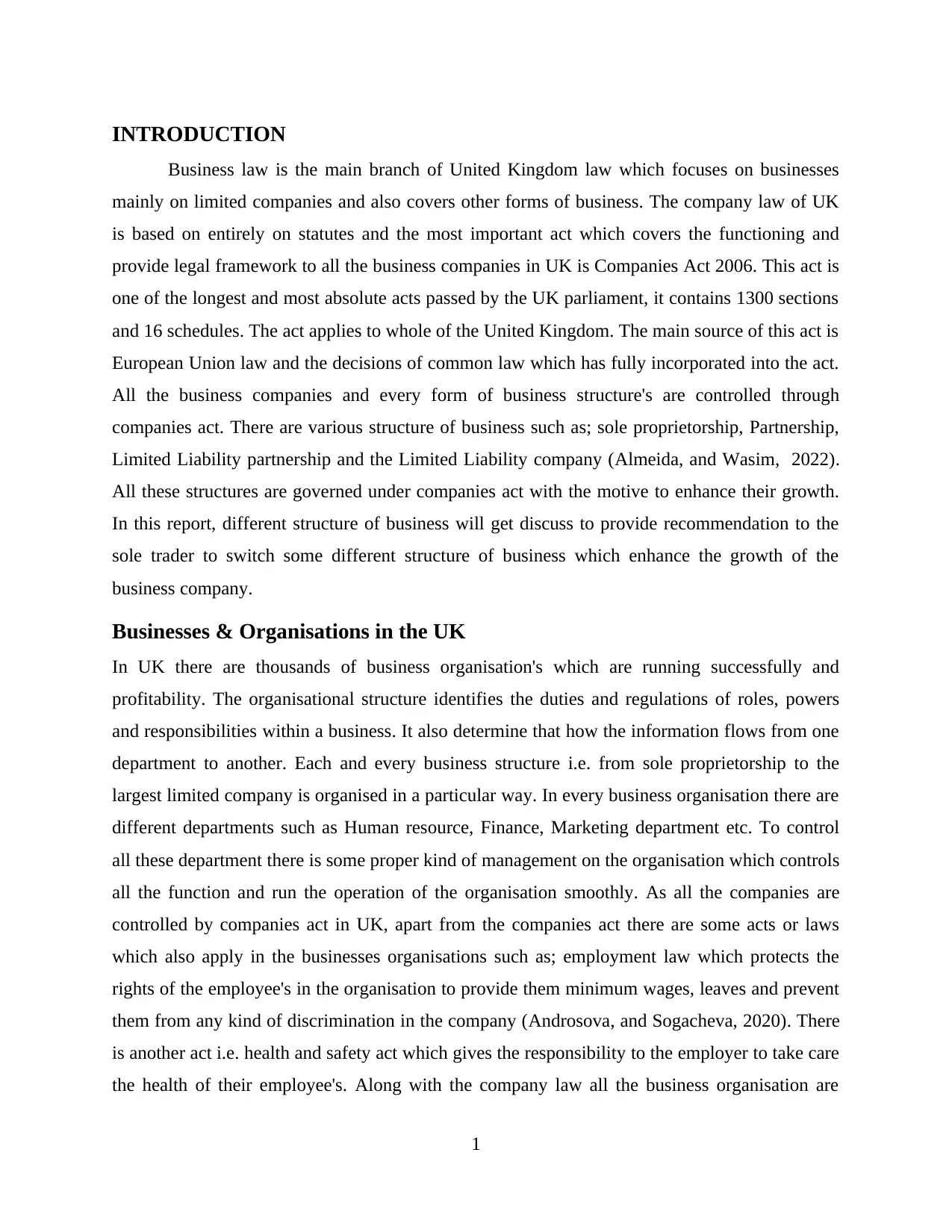
INTRODUCTION
Business law is the main branch of United Kingdom law which focuses on businesses
mainly on limited companies and also covers other forms of business. The company law of UK
is based on entirely on statutes and the most important act which covers the functioning and
provide legal framework to all the business companies in UK is Companies Act 2006. This act is
one of the longest and most absolute acts passed by the UK parliament, it contains 1300 sections
and 16 schedules. The act applies to whole of the United Kingdom. The main source of this act is
European Union law and the decisions of common law which has fully incorporated into the act.
All the business companies and every form of business structure's are controlled through
companies act. There are various structure of business such as; sole proprietorship, Partnership,
Limited Liability partnership and the Limited Liability company (Almeida, and Wasim, 2022).
All these structures are governed under companies act with the motive to enhance their growth.
In this report, different structure of business will get discuss to provide recommendation to the
sole trader to switch some different structure of business which enhance the growth of the
business company.
Businesses & Organisations in the UK
In UK there are thousands of business organisation's which are running successfully and
profitability. The organisational structure identifies the duties and regulations of roles, powers
and responsibilities within a business. It also determine that how the information flows from one
department to another. Each and every business structure i.e. from sole proprietorship to the
largest limited company is organised in a particular way. In every business organisation there are
different departments such as Human resource, Finance, Marketing department etc. To control
all these department there is some proper kind of management on the organisation which controls
all the function and run the operation of the organisation smoothly. As all the companies are
controlled by companies act in UK, apart from the companies act there are some acts or laws
which also apply in the businesses organisations such as; employment law which protects the
rights of the employee's in the organisation to provide them minimum wages, leaves and prevent
them from any kind of discrimination in the company (Androsova, and Sogacheva, 2020). There
is another act i.e. health and safety act which gives the responsibility to the employer to take care
the health of their employee's. Along with the company law all the business organisation are
1
Business law is the main branch of United Kingdom law which focuses on businesses
mainly on limited companies and also covers other forms of business. The company law of UK
is based on entirely on statutes and the most important act which covers the functioning and
provide legal framework to all the business companies in UK is Companies Act 2006. This act is
one of the longest and most absolute acts passed by the UK parliament, it contains 1300 sections
and 16 schedules. The act applies to whole of the United Kingdom. The main source of this act is
European Union law and the decisions of common law which has fully incorporated into the act.
All the business companies and every form of business structure's are controlled through
companies act. There are various structure of business such as; sole proprietorship, Partnership,
Limited Liability partnership and the Limited Liability company (Almeida, and Wasim, 2022).
All these structures are governed under companies act with the motive to enhance their growth.
In this report, different structure of business will get discuss to provide recommendation to the
sole trader to switch some different structure of business which enhance the growth of the
business company.
Businesses & Organisations in the UK
In UK there are thousands of business organisation's which are running successfully and
profitability. The organisational structure identifies the duties and regulations of roles, powers
and responsibilities within a business. It also determine that how the information flows from one
department to another. Each and every business structure i.e. from sole proprietorship to the
largest limited company is organised in a particular way. In every business organisation there are
different departments such as Human resource, Finance, Marketing department etc. To control
all these department there is some proper kind of management on the organisation which controls
all the function and run the operation of the organisation smoothly. As all the companies are
controlled by companies act in UK, apart from the companies act there are some acts or laws
which also apply in the businesses organisations such as; employment law which protects the
rights of the employee's in the organisation to provide them minimum wages, leaves and prevent
them from any kind of discrimination in the company (Androsova, and Sogacheva, 2020). There
is another act i.e. health and safety act which gives the responsibility to the employer to take care
the health of their employee's. Along with the company law all the business organisation are
1
Paraphrase This Document
Need a fresh take? Get an instant paraphrase of this document with our AI Paraphraser
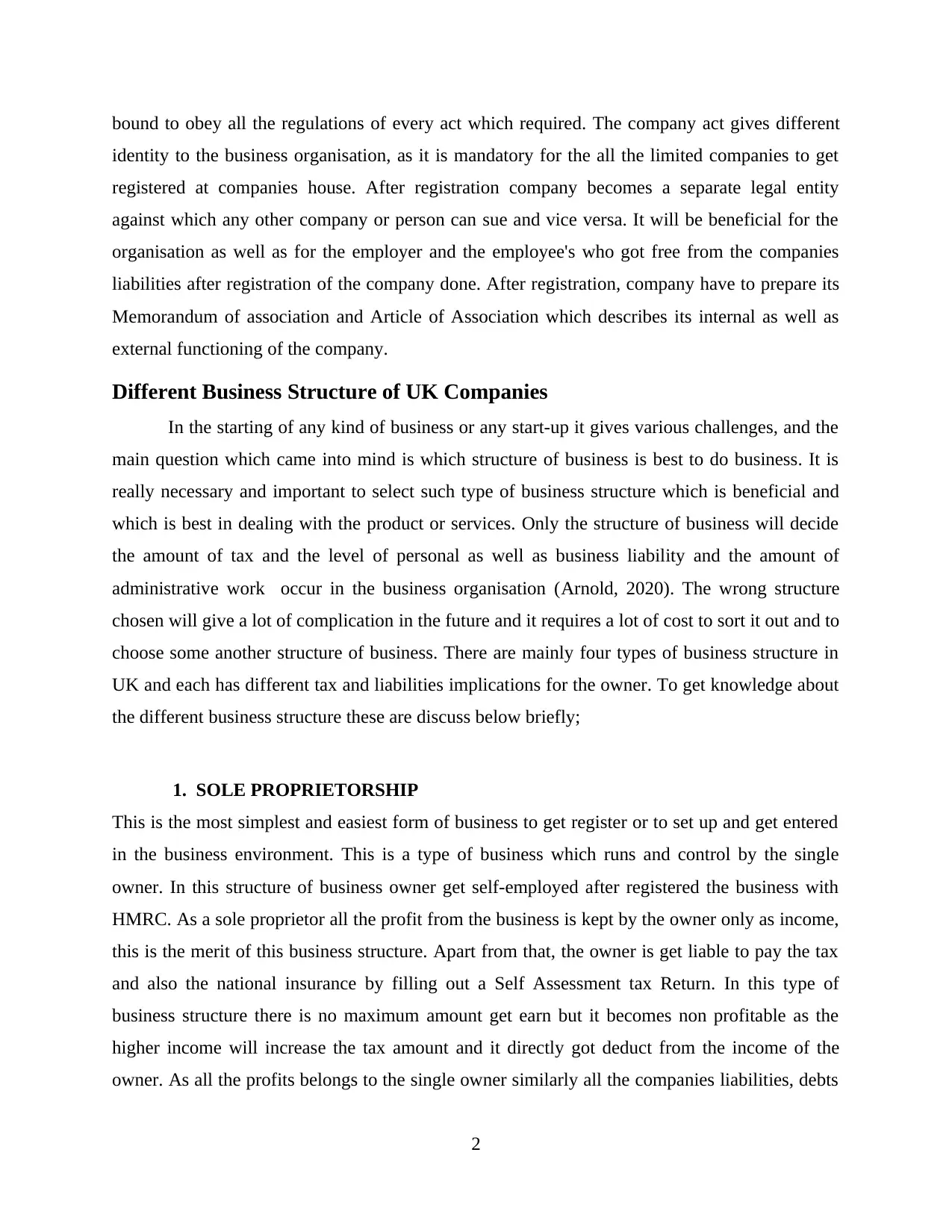
bound to obey all the regulations of every act which required. The company act gives different
identity to the business organisation, as it is mandatory for the all the limited companies to get
registered at companies house. After registration company becomes a separate legal entity
against which any other company or person can sue and vice versa. It will be beneficial for the
organisation as well as for the employer and the employee's who got free from the companies
liabilities after registration of the company done. After registration, company have to prepare its
Memorandum of association and Article of Association which describes its internal as well as
external functioning of the company.
Different Business Structure of UK Companies
In the starting of any kind of business or any start-up it gives various challenges, and the
main question which came into mind is which structure of business is best to do business. It is
really necessary and important to select such type of business structure which is beneficial and
which is best in dealing with the product or services. Only the structure of business will decide
the amount of tax and the level of personal as well as business liability and the amount of
administrative work occur in the business organisation (Arnold, 2020). The wrong structure
chosen will give a lot of complication in the future and it requires a lot of cost to sort it out and to
choose some another structure of business. There are mainly four types of business structure in
UK and each has different tax and liabilities implications for the owner. To get knowledge about
the different business structure these are discuss below briefly;
1. SOLE PROPRIETORSHIP
This is the most simplest and easiest form of business to get register or to set up and get entered
in the business environment. This is a type of business which runs and control by the single
owner. In this structure of business owner get self-employed after registered the business with
HMRC. As a sole proprietor all the profit from the business is kept by the owner only as income,
this is the merit of this business structure. Apart from that, the owner is get liable to pay the tax
and also the national insurance by filling out a Self Assessment tax Return. In this type of
business structure there is no maximum amount get earn but it becomes non profitable as the
higher income will increase the tax amount and it directly got deduct from the income of the
owner. As all the profits belongs to the single owner similarly all the companies liabilities, debts
2
identity to the business organisation, as it is mandatory for the all the limited companies to get
registered at companies house. After registration company becomes a separate legal entity
against which any other company or person can sue and vice versa. It will be beneficial for the
organisation as well as for the employer and the employee's who got free from the companies
liabilities after registration of the company done. After registration, company have to prepare its
Memorandum of association and Article of Association which describes its internal as well as
external functioning of the company.
Different Business Structure of UK Companies
In the starting of any kind of business or any start-up it gives various challenges, and the
main question which came into mind is which structure of business is best to do business. It is
really necessary and important to select such type of business structure which is beneficial and
which is best in dealing with the product or services. Only the structure of business will decide
the amount of tax and the level of personal as well as business liability and the amount of
administrative work occur in the business organisation (Arnold, 2020). The wrong structure
chosen will give a lot of complication in the future and it requires a lot of cost to sort it out and to
choose some another structure of business. There are mainly four types of business structure in
UK and each has different tax and liabilities implications for the owner. To get knowledge about
the different business structure these are discuss below briefly;
1. SOLE PROPRIETORSHIP
This is the most simplest and easiest form of business to get register or to set up and get entered
in the business environment. This is a type of business which runs and control by the single
owner. In this structure of business owner get self-employed after registered the business with
HMRC. As a sole proprietor all the profit from the business is kept by the owner only as income,
this is the merit of this business structure. Apart from that, the owner is get liable to pay the tax
and also the national insurance by filling out a Self Assessment tax Return. In this type of
business structure there is no maximum amount get earn but it becomes non profitable as the
higher income will increase the tax amount and it directly got deduct from the income of the
owner. As all the profits belongs to the single owner similarly all the companies liabilities, debts
2
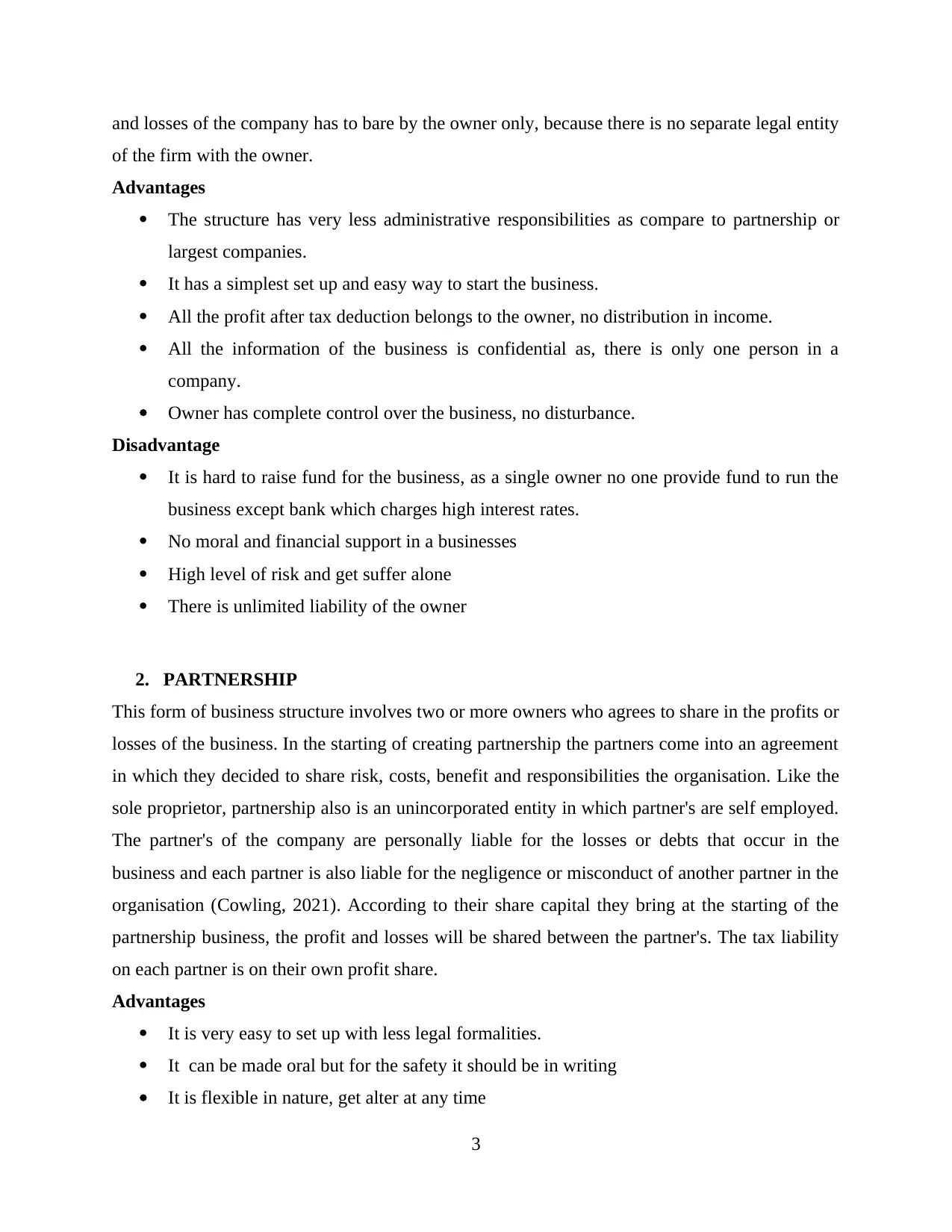
and losses of the company has to bare by the owner only, because there is no separate legal entity
of the firm with the owner.
Advantages
The structure has very less administrative responsibilities as compare to partnership or
largest companies.
It has a simplest set up and easy way to start the business.
All the profit after tax deduction belongs to the owner, no distribution in income.
All the information of the business is confidential as, there is only one person in a
company.
Owner has complete control over the business, no disturbance.
Disadvantage
It is hard to raise fund for the business, as a single owner no one provide fund to run the
business except bank which charges high interest rates.
No moral and financial support in a businesses
High level of risk and get suffer alone
There is unlimited liability of the owner
2. PARTNERSHIP
This form of business structure involves two or more owners who agrees to share in the profits or
losses of the business. In the starting of creating partnership the partners come into an agreement
in which they decided to share risk, costs, benefit and responsibilities the organisation. Like the
sole proprietor, partnership also is an unincorporated entity in which partner's are self employed.
The partner's of the company are personally liable for the losses or debts that occur in the
business and each partner is also liable for the negligence or misconduct of another partner in the
organisation (Cowling, 2021). According to their share capital they bring at the starting of the
partnership business, the profit and losses will be shared between the partner's. The tax liability
on each partner is on their own profit share.
Advantages
It is very easy to set up with less legal formalities.
It can be made oral but for the safety it should be in writing
It is flexible in nature, get alter at any time
3
of the firm with the owner.
Advantages
The structure has very less administrative responsibilities as compare to partnership or
largest companies.
It has a simplest set up and easy way to start the business.
All the profit after tax deduction belongs to the owner, no distribution in income.
All the information of the business is confidential as, there is only one person in a
company.
Owner has complete control over the business, no disturbance.
Disadvantage
It is hard to raise fund for the business, as a single owner no one provide fund to run the
business except bank which charges high interest rates.
No moral and financial support in a businesses
High level of risk and get suffer alone
There is unlimited liability of the owner
2. PARTNERSHIP
This form of business structure involves two or more owners who agrees to share in the profits or
losses of the business. In the starting of creating partnership the partners come into an agreement
in which they decided to share risk, costs, benefit and responsibilities the organisation. Like the
sole proprietor, partnership also is an unincorporated entity in which partner's are self employed.
The partner's of the company are personally liable for the losses or debts that occur in the
business and each partner is also liable for the negligence or misconduct of another partner in the
organisation (Cowling, 2021). According to their share capital they bring at the starting of the
partnership business, the profit and losses will be shared between the partner's. The tax liability
on each partner is on their own profit share.
Advantages
It is very easy to set up with less legal formalities.
It can be made oral but for the safety it should be in writing
It is flexible in nature, get alter at any time
3
⊘ This is a preview!⊘
Do you want full access?
Subscribe today to unlock all pages.

Trusted by 1+ million students worldwide
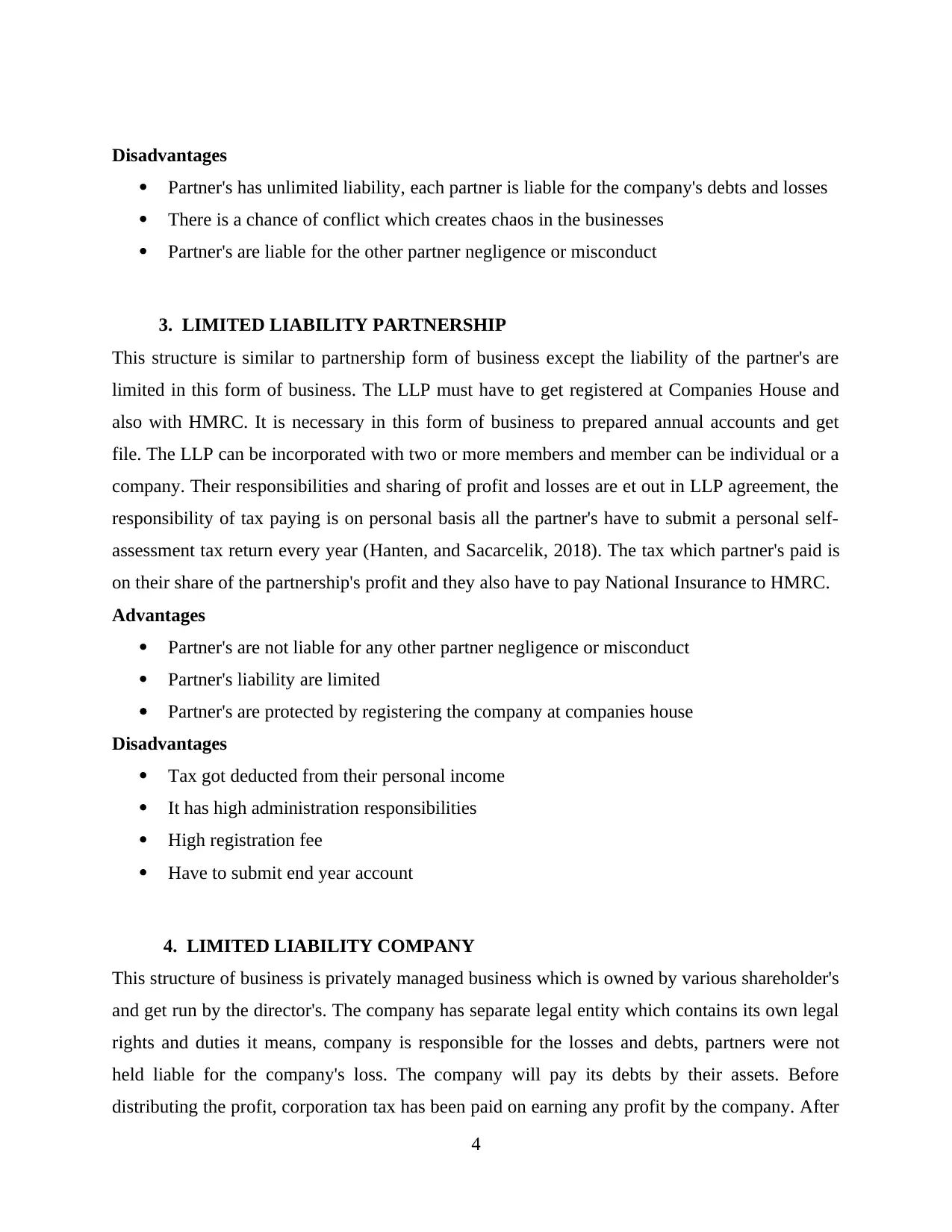
Disadvantages
Partner's has unlimited liability, each partner is liable for the company's debts and losses
There is a chance of conflict which creates chaos in the businesses
Partner's are liable for the other partner negligence or misconduct
3. LIMITED LIABILITY PARTNERSHIP
This structure is similar to partnership form of business except the liability of the partner's are
limited in this form of business. The LLP must have to get registered at Companies House and
also with HMRC. It is necessary in this form of business to prepared annual accounts and get
file. The LLP can be incorporated with two or more members and member can be individual or a
company. Their responsibilities and sharing of profit and losses are et out in LLP agreement, the
responsibility of tax paying is on personal basis all the partner's have to submit a personal self-
assessment tax return every year (Hanten, and Sacarcelik, 2018). The tax which partner's paid is
on their share of the partnership's profit and they also have to pay National Insurance to HMRC.
Advantages
Partner's are not liable for any other partner negligence or misconduct
Partner's liability are limited
Partner's are protected by registering the company at companies house
Disadvantages
Tax got deducted from their personal income
It has high administration responsibilities
High registration fee
Have to submit end year account
4. LIMITED LIABILITY COMPANY
This structure of business is privately managed business which is owned by various shareholder's
and get run by the director's. The company has separate legal entity which contains its own legal
rights and duties it means, company is responsible for the losses and debts, partners were not
held liable for the company's loss. The company will pay its debts by their assets. Before
distributing the profit, corporation tax has been paid on earning any profit by the company. After
4
Partner's has unlimited liability, each partner is liable for the company's debts and losses
There is a chance of conflict which creates chaos in the businesses
Partner's are liable for the other partner negligence or misconduct
3. LIMITED LIABILITY PARTNERSHIP
This structure is similar to partnership form of business except the liability of the partner's are
limited in this form of business. The LLP must have to get registered at Companies House and
also with HMRC. It is necessary in this form of business to prepared annual accounts and get
file. The LLP can be incorporated with two or more members and member can be individual or a
company. Their responsibilities and sharing of profit and losses are et out in LLP agreement, the
responsibility of tax paying is on personal basis all the partner's have to submit a personal self-
assessment tax return every year (Hanten, and Sacarcelik, 2018). The tax which partner's paid is
on their share of the partnership's profit and they also have to pay National Insurance to HMRC.
Advantages
Partner's are not liable for any other partner negligence or misconduct
Partner's liability are limited
Partner's are protected by registering the company at companies house
Disadvantages
Tax got deducted from their personal income
It has high administration responsibilities
High registration fee
Have to submit end year account
4. LIMITED LIABILITY COMPANY
This structure of business is privately managed business which is owned by various shareholder's
and get run by the director's. The company has separate legal entity which contains its own legal
rights and duties it means, company is responsible for the losses and debts, partners were not
held liable for the company's loss. The company will pay its debts by their assets. Before
distributing the profit, corporation tax has been paid on earning any profit by the company. After
4
Paraphrase This Document
Need a fresh take? Get an instant paraphrase of this document with our AI Paraphraser
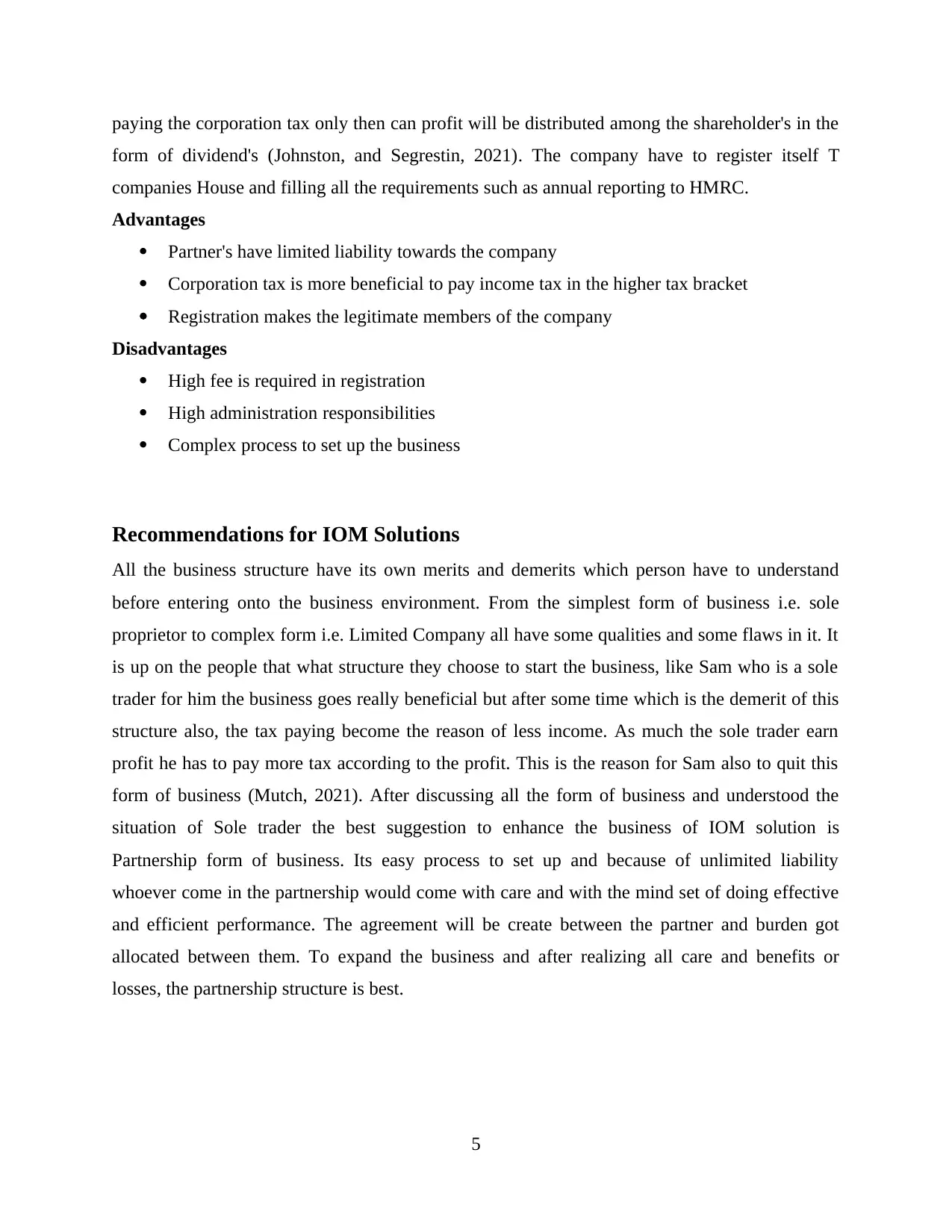
paying the corporation tax only then can profit will be distributed among the shareholder's in the
form of dividend's (Johnston, and Segrestin, 2021). The company have to register itself T
companies House and filling all the requirements such as annual reporting to HMRC.
Advantages
Partner's have limited liability towards the company
Corporation tax is more beneficial to pay income tax in the higher tax bracket
Registration makes the legitimate members of the company
Disadvantages
High fee is required in registration
High administration responsibilities
Complex process to set up the business
Recommendations for IOM Solutions
All the business structure have its own merits and demerits which person have to understand
before entering onto the business environment. From the simplest form of business i.e. sole
proprietor to complex form i.e. Limited Company all have some qualities and some flaws in it. It
is up on the people that what structure they choose to start the business, like Sam who is a sole
trader for him the business goes really beneficial but after some time which is the demerit of this
structure also, the tax paying become the reason of less income. As much the sole trader earn
profit he has to pay more tax according to the profit. This is the reason for Sam also to quit this
form of business (Mutch, 2021). After discussing all the form of business and understood the
situation of Sole trader the best suggestion to enhance the business of IOM solution is
Partnership form of business. Its easy process to set up and because of unlimited liability
whoever come in the partnership would come with care and with the mind set of doing effective
and efficient performance. The agreement will be create between the partner and burden got
allocated between them. To expand the business and after realizing all care and benefits or
losses, the partnership structure is best.
5
form of dividend's (Johnston, and Segrestin, 2021). The company have to register itself T
companies House and filling all the requirements such as annual reporting to HMRC.
Advantages
Partner's have limited liability towards the company
Corporation tax is more beneficial to pay income tax in the higher tax bracket
Registration makes the legitimate members of the company
Disadvantages
High fee is required in registration
High administration responsibilities
Complex process to set up the business
Recommendations for IOM Solutions
All the business structure have its own merits and demerits which person have to understand
before entering onto the business environment. From the simplest form of business i.e. sole
proprietor to complex form i.e. Limited Company all have some qualities and some flaws in it. It
is up on the people that what structure they choose to start the business, like Sam who is a sole
trader for him the business goes really beneficial but after some time which is the demerit of this
structure also, the tax paying become the reason of less income. As much the sole trader earn
profit he has to pay more tax according to the profit. This is the reason for Sam also to quit this
form of business (Mutch, 2021). After discussing all the form of business and understood the
situation of Sole trader the best suggestion to enhance the business of IOM solution is
Partnership form of business. Its easy process to set up and because of unlimited liability
whoever come in the partnership would come with care and with the mind set of doing effective
and efficient performance. The agreement will be create between the partner and burden got
allocated between them. To expand the business and after realizing all care and benefits or
losses, the partnership structure is best.
5
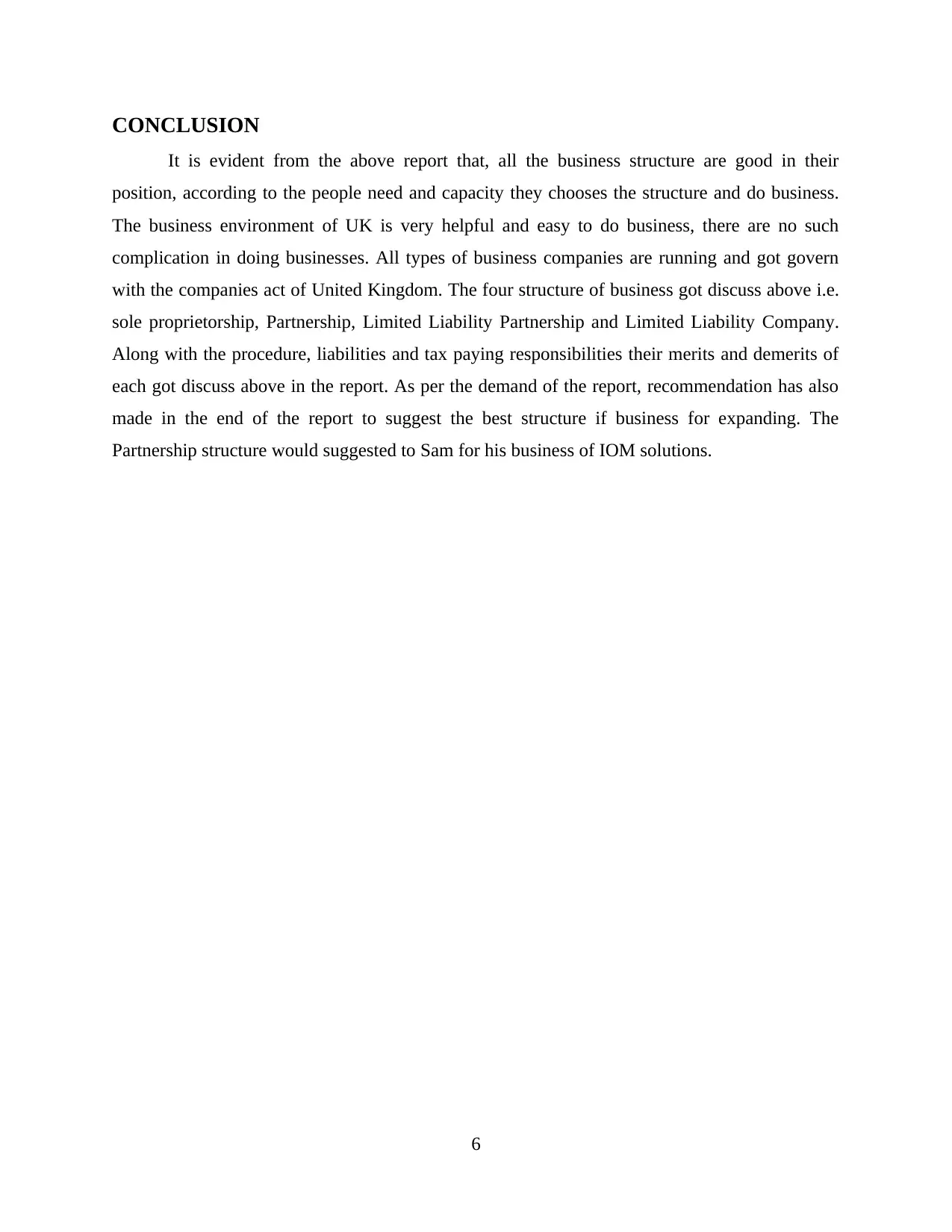
CONCLUSION
It is evident from the above report that, all the business structure are good in their
position, according to the people need and capacity they chooses the structure and do business.
The business environment of UK is very helpful and easy to do business, there are no such
complication in doing businesses. All types of business companies are running and got govern
with the companies act of United Kingdom. The four structure of business got discuss above i.e.
sole proprietorship, Partnership, Limited Liability Partnership and Limited Liability Company.
Along with the procedure, liabilities and tax paying responsibilities their merits and demerits of
each got discuss above in the report. As per the demand of the report, recommendation has also
made in the end of the report to suggest the best structure if business for expanding. The
Partnership structure would suggested to Sam for his business of IOM solutions.
6
It is evident from the above report that, all the business structure are good in their
position, according to the people need and capacity they chooses the structure and do business.
The business environment of UK is very helpful and easy to do business, there are no such
complication in doing businesses. All types of business companies are running and got govern
with the companies act of United Kingdom. The four structure of business got discuss above i.e.
sole proprietorship, Partnership, Limited Liability Partnership and Limited Liability Company.
Along with the procedure, liabilities and tax paying responsibilities their merits and demerits of
each got discuss above in the report. As per the demand of the report, recommendation has also
made in the end of the report to suggest the best structure if business for expanding. The
Partnership structure would suggested to Sam for his business of IOM solutions.
6
⊘ This is a preview!⊘
Do you want full access?
Subscribe today to unlock all pages.

Trusted by 1+ million students worldwide
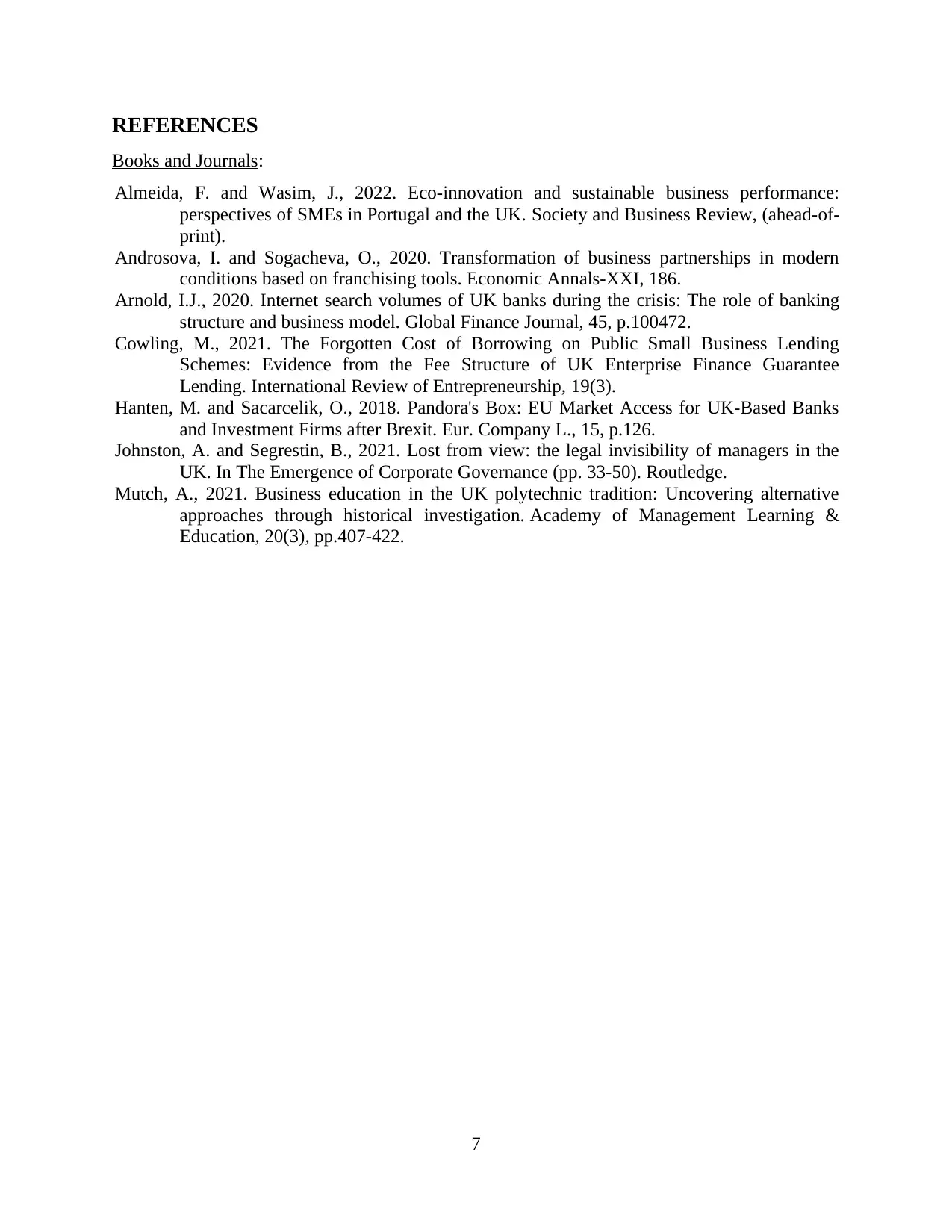
REFERENCES
Books and Journals:
Almeida, F. and Wasim, J., 2022. Eco-innovation and sustainable business performance:
perspectives of SMEs in Portugal and the UK. Society and Business Review, (ahead-of-
print).
Androsova, I. and Sogacheva, O., 2020. Transformation of business partnerships in modern
conditions based on franchising tools. Economic Annals-XXI, 186.
Arnold, I.J., 2020. Internet search volumes of UK banks during the crisis: The role of banking
structure and business model. Global Finance Journal, 45, p.100472.
Cowling, M., 2021. The Forgotten Cost of Borrowing on Public Small Business Lending
Schemes: Evidence from the Fee Structure of UK Enterprise Finance Guarantee
Lending. International Review of Entrepreneurship, 19(3).
Hanten, M. and Sacarcelik, O., 2018. Pandora's Box: EU Market Access for UK-Based Banks
and Investment Firms after Brexit. Eur. Company L., 15, p.126.
Johnston, A. and Segrestin, B., 2021. Lost from view: the legal invisibility of managers in the
UK. In The Emergence of Corporate Governance (pp. 33-50). Routledge.
Mutch, A., 2021. Business education in the UK polytechnic tradition: Uncovering alternative
approaches through historical investigation. Academy of Management Learning &
Education, 20(3), pp.407-422.
7
Books and Journals:
Almeida, F. and Wasim, J., 2022. Eco-innovation and sustainable business performance:
perspectives of SMEs in Portugal and the UK. Society and Business Review, (ahead-of-
print).
Androsova, I. and Sogacheva, O., 2020. Transformation of business partnerships in modern
conditions based on franchising tools. Economic Annals-XXI, 186.
Arnold, I.J., 2020. Internet search volumes of UK banks during the crisis: The role of banking
structure and business model. Global Finance Journal, 45, p.100472.
Cowling, M., 2021. The Forgotten Cost of Borrowing on Public Small Business Lending
Schemes: Evidence from the Fee Structure of UK Enterprise Finance Guarantee
Lending. International Review of Entrepreneurship, 19(3).
Hanten, M. and Sacarcelik, O., 2018. Pandora's Box: EU Market Access for UK-Based Banks
and Investment Firms after Brexit. Eur. Company L., 15, p.126.
Johnston, A. and Segrestin, B., 2021. Lost from view: the legal invisibility of managers in the
UK. In The Emergence of Corporate Governance (pp. 33-50). Routledge.
Mutch, A., 2021. Business education in the UK polytechnic tradition: Uncovering alternative
approaches through historical investigation. Academy of Management Learning &
Education, 20(3), pp.407-422.
7
1 out of 10
Related Documents
Your All-in-One AI-Powered Toolkit for Academic Success.
+13062052269
info@desklib.com
Available 24*7 on WhatsApp / Email
![[object Object]](/_next/static/media/star-bottom.7253800d.svg)
Unlock your academic potential
Copyright © 2020–2025 A2Z Services. All Rights Reserved. Developed and managed by ZUCOL.
